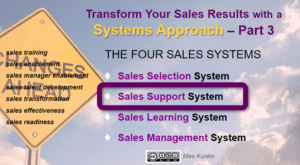
In this 5-part series of blogs, he speaks to how sales managers and sales professionals should be viewing and implementing the 4 sales systems. Here’s Part 3.
In part 1 of this series, I wrote about the challenges we face in the sales profession and shared my opinion that the solution to our current sales problems – and the vehicle for transforming your sales results – is a Systems Approach to Sales.
In Part 2 of the series, I highlighted the Sales Selection System.
In this Part 3 post, I will share the details of the Sales Support System.
 The first element in the Sales Support System is knowing your market and buyers. You can read elsewhere (like here, here, here and here) about the different approaches to building buyer personas. Good personas include so much more than a “profile” of your buyers, but I still think that concept helps most people grasp what a persona is.
The first element in the Sales Support System is knowing your market and buyers. You can read elsewhere (like here, here, here and here) about the different approaches to building buyer personas. Good personas include so much more than a “profile” of your buyers, but I still think that concept helps most people grasp what a persona is.
- Who buys from you? What are their roles/titles and responsibilities? What size company are they typically working in?
- What problems, opportunities, and risks (PRO) do they face? What are their needs and wants (relative to the problems you can solve)?
- How are they measured? What are the metrics that really matter?
- What is their typical budget?
- What are the implications of not effectively addressing those PROs?
- What happens if they fail at addressing the PROs? What are the upsides for them, if they do succeed?
- What other pressures are they under?
- Who else in their organization do they typically work with?
- What is their buying process and decision process, when they act to seek solutions?
- What are their decision criteria – what verifiable outcomes and buying process exit criteria are important to them, at each stage of their journey (meaning: what do they need to see, hear, feel, know and/or believe at each stage to feel comfortable moving forward to the next stage of their journey, with you)?
Read the continuation of this 5 part blog series here.






